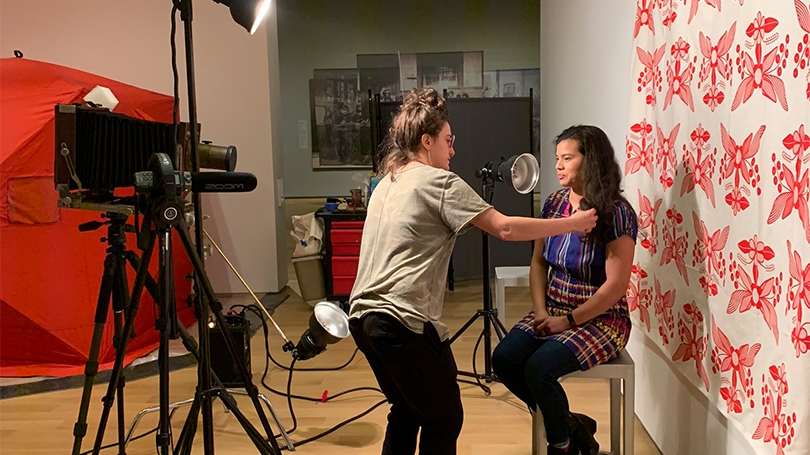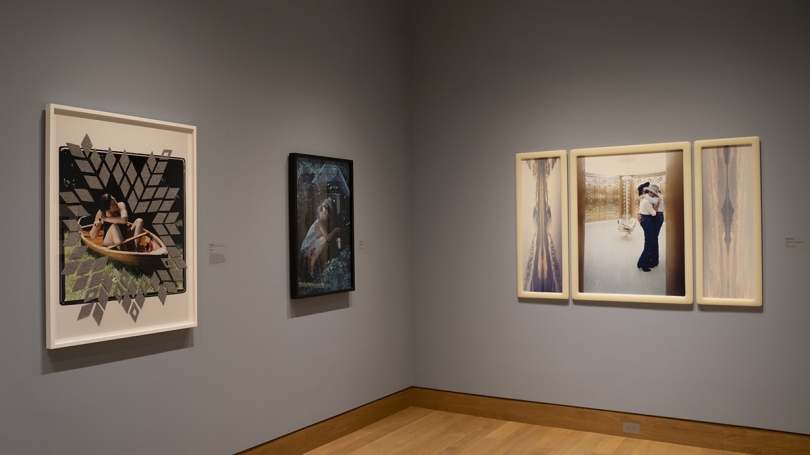As part of Women's History Month this year, the Hood Museum of Art is participating in the National Museum of Women in the Art's annual #5WomenArtists campaign. Assistant Registrar Nicole S. Williams writes about five works by five Native American artists represented in the Hood Museum's permanent collection.
With their work, the five artists featured below touch on issues of identity, history, gender, land rights, and more. They tell new and vibrant stories while honoring the memory of their ancestors and ask viewers to consider what they know about the visual representation of Native and indigenous peoples.
In her Ancestor Beadwork Prism Series, artist GINA ADAMS merges history with contemporary visual aesthetics to engage in important and necessary dialogue around the subjugation of her ancestors, to honor their memory while also searching for her own connections and identity to her heritage. It was while doing research at the National Museum of the American Indian in Washington, D.C., that Adams found photographs of her ancestors. She repurposed the images by creating "digital beadwork prisms" in which she used patterns she found in the carpets and curtains in the photographs to electronically compose the colorful background she places behind the historic photograph. This is how she combines connections to her history with a contemporary medium to create something entirely new, breathing fresh life into stories she grew up hearing.
KALI SPITZER photographed many members of the Dartmouth community as part of the Critical Indigenous Photographic Exchange (CIPX) project hosted by the Hood Museum of Art in January 2020. She worked with the wet plate collodion process using an 8x10 camera to take the portraits, a method used nearly a century ago as a means of ethnographic photography of Native Americans. Reframing the narrative, Spitzer, in collaboration with Will Wilson, who conceived the CIPX project, gives the sitter control over their own image and representation. She also invites the sitter to see their image develop in the darkroom and, as part of the project, the photographer gives the physical tintype (original image) to the sitter in exchange for a digital version the photographer will keep.
As Spitzer explains: "To ask people to be vulnerable and share themselves with me, through the work and then with other people by showing the work — it's just really important that you have a connection with that person. And being of mixed heritage, I really wanted to highlight Indigenous, black and brown, women, queer, trans, non-binary people, and that was also a lot of my peers living in New Mexico."
In Oil Boom, photographer CARA ROMERO creates a visual narrative that engenders dialogue around both environment and identity. With a background in film, digital, fine art, journalism, editorial portraiture, and commercial photography, Romero is skilled at storytelling through the visual. The viewer can see the figure's body floating downward while pump jacks extract oil above. Romero highlights the struggles between binaries such as human consumption and natural resources, land rights and big business, expansion and Native American identity. She also works to expand perceptions of what contemporary indigenous art can be through a range of subjects in her photography.
She states: "I realized that a picture says so much. I am a mainstream, indigenous person who lives within pop culture and contemporary society – but at the same time, it's a really unique perspective that most documentary makers aren't capturing. I like to hone in on those ideas of where we are at now, in the present day. Making sure to always pay homage to our ancestral ties and our Indian-ness."
While much of MARIA HUPFIELD'S work is performative, sculptural, and installation-based, with a focus on creating moments of possibility and new narratives, Diamond is a photograph that explores her interest in intersectionality, Indigenous feminisms, and craft and textiles art. Here, Hupfield photographs herself sitting in a wood canoe, wringing out her wet hair. However, the boat sits on green grass, not floating in water at all. Additionally, diamond-shaped felt surrounds her body, not only drawing the focus into her performative action of hands on hair but also incorporating a fiber element into the work—mixing "non-traditional" media, felt and photography, to create something that speaks to identity and pushes against standards of fine art photography. Hupfield also flips the stereotypical image of a Native woman in a canoe (think Pocahontas) to a contemporary scene of a modern woman finding herself out of water.
WENDY RED STAR's series The Four Seasons is a critical yet humorous take on the stereotypical Western representation of Native Americans within natural history museums. After a trip to the Native American section of the Los Angeles Natural History Museum, Red Star decided to make her own diorama: "I strolled by the dioramas and found in them the same cold quality as the display of my ancestor's moccasin. I decided to construct my own version of a diorama and to convey how this format of display makes me feel."
In The Four Seasons series, Red Star mocks these dated forms of display with her own artificial scenes. In Spring, viewers can see the crease marks of the paper landscape backdrop that meets vivid green artificial grass accompanied by plastic flowers and paper animal cutouts. The artist situates herself in the middle of the image in full regalia, however, and her gaze is directed at the viewer.
With a background in photography, sculpture, video, fiber arts, and performance, Red Star is also a researcher of archives and historical narratives, which she incorporates into her work in ways that interrogate and subvert the status quo. The vibrant colors of Spring draw the viewer in, but one must look closely at the elements of the image to find that Red Start is prompting us to think about and question preconceived notions of Native American history, culture, and contemporary experience.
Written by Nicole S. Williams, Assistant Registrar
About the author: In her position, Nicole S. Williams assists in the documentation of all art and objects coming in and out of the museum. She enjoys unpacking incoming work and thinking about how it will contribute to the collection, where it will be stored when it is not on view, and how the museum will care for it long-term. Over the last few years, Nicole has enjoyed working with Associate Curator of Native American Art Jami Powell as she has acquired work by contemporary Native and indigenous artists, including many of the photographs shared here.




